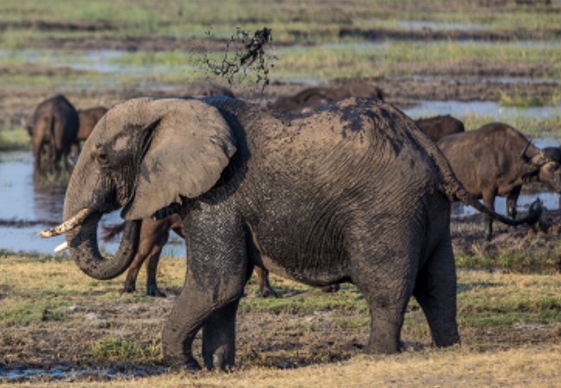Of the three extant elephant species, two inhabit Africa: the African bush or savanna elephant, Loxodonta africana; and the smaller African forest elephant, L. cyclotis. The African bush elephant is the largest living land mammal and is primarily found in open savannas, grassy plains, woodlands, and scrub forests of Sub-Saharan Africa. About one-third of the world's population of L. africana lives in Botswana in southern Africa. Because of robust and strictly enforced conservation programs, this population totals approximately 130,000 individuals. Now, though, conservationists are concerned about a mysterious ailment that has killed hundreds of elephants in Botswana since March 2020. See also: Africa; Conservation of species; Elephant; Proboscidea; Savanna

Starting in March 2020, aerial surveys began to detect an unusually large number of L. africana carcasses in the Okavango Delta region of northern Botswana, which comprises seasonally flooded plains and marshlands. Further surveys in the Okavango Delta in May and late June 2020 verified the presence of at least 356 carcasses. As surveys have not been adequately undertaken in all locations of the Okavango Delta, conservationists estimate that more than 400 African bush elephants have likely died since March 2020. Importantly, as the ivory tusks of these elephants remained intact, poaching has been ruled out as a cause of death. Therefore, scientists are seeking the exact reason (or reasons) for this large die-off of bush elephants. See also: Conservation of resources; Use of UAV drones to protect elephants
In the past, Botswana's L. africana population has been reduced by drought or outbreaks of anthrax—an infectious disease caused by Bacillus anthracis, a naturally occurring bacterium in soil. These two causes have been ruled out at the present time. Some scientists suggest that cyanide poisoning of water holes, which poachers have used as a method to kill elephants, could be the culprit. Cyanide poisoning typically affects the nervous system, often leading to sudden collapse and death. Coincidentally, conservation groups working presently in the Okavango Delta region have observed disoriented bush elephants walking in circles, other bush elephants with hindered hind-leg movements, and emaciated individuals. However, field surveys have not detected the presence of other animal carcasses (because presumably other animals would be equally affected by drinking from contaminated water holes), and no unusual neurological abnormalities have been observed in other wildlife in the Okavango Delta. See also: Anthrax; Cyanide; Drought; Nervous system (vertebrate); Poison
At present, scientists are awaiting results from bacterial and toxicology tests of L. africana carcass tissues. Some animal epidemiologists suspect that a naturally occurring pathogenic disease may be the cause. For example, encephalomyocarditis—a viral infection transmitted by rodents—is detrimental to mammalian neurological functioning and was responsible for killing dozens of elephants in South Africa in the 1990s. See also: Epidemiology; Pathogen; Toxicology
A further aerial survey conducted in late July 2020 found no additional L. africana carcasses, adding to the puzzling nature of the die-off. Although the initial 400 or so L. africana deaths do not comprise a conservation crisis or a significant mortality in terms of percentage of the total population, any vulnerability of the species—especially one caused by an unidentified culprit—is troubling and could lead to further deaths. Thus, scientists hope to identify the exact cause of the die-off for the safety and health of all bush elephants in Africa. See also: Endangered species





